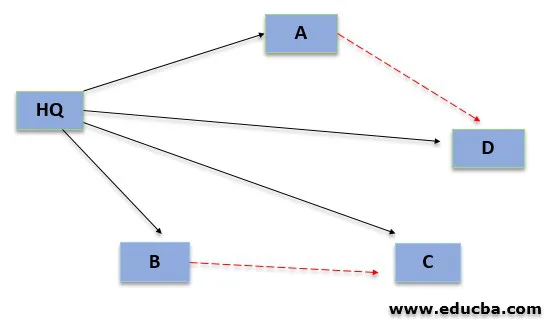
What is Partial Mesh Topology?
Topology means the study of mapping things one among others. Partial mesh topology is a way to map multiple routers in such a way that they are tightly coupled among themselves but not fully inter-connected. Talking of partial mesh it becomes important for us to discuss briefly the mesh as both are interrelated to each other. Mesh topology is a network structure where each system or network device is connected to every other system of devices. These are mainly used for wireless communications.
Block Diagram
We have illustrated a block diagram which has the following components; let us see them first – this is an example
- Here, HQ is the center where all the details come (kind of the main center)
- A: is research & development (e.g.)
- B: is HR (human resource) (e.g.)
- C: is the payroll (e.g.)
- D: is the engineering site (e.g.)
Note: That (A and D communicate frequently) & (B & C communicate frequently)

So we have seen this diagram and understood what block constitute, now moving to the lines (red and black),
- Red dotted lines mean the communication is frequent but there is no direct linkage
- Black line means the connections have frequent communication between them
Explanation: With these red dotted lines between AD and BC we are eliminating the need to go HQ all the time for communication to complete and so we have added these partial connection lines between these ends. So a partial mesh is a subset of the full mesh topology, here we eliminate our need to go to head center all the time rather we make partial connections to ease our process. In partial mesh, the links are arranged strategically based on frequent operating paths or signals to ease of usage.
Need for Partial Mesh Topology
Users of partial mesh definitely have better usability and time management but there are additional benefits of having a partial mesh network in your organization.
- In a partial mesh topology, there is no such thing called as centralized regulatory, for any number of connections in the network no admin or controller exists.
- They are applicable to WAN’s so definitely they are made to cover very large geographical areas. WANs, as we know, are wide area networks that are suitable to handle areas with large crowds, numerous devices or areas covering remote.
- A partial WAN topology is more redundant than a Hub and spoke WAN topology, a Partial WAN somewhere lays in between Mesh and Spoke in terms of expenditure. It is less expensive then Mesh and costlier than Spoke.
- The network is highly robust and it is almost very difficult to take the network down. Also if the connection breakdown is there the user will not lose any of the data as it is not hosted centrally in one location.
- There are some golden rules under the topology usage and since the partial mesh inherits all the quality of topology architecture we can say that a partial mesh topology creates datasets with better managing capabilities with greater data integrity facility. Easy validation and tracking facility for any misconduct that takes place.
Importance of Partial Mesh Topology
There are multiple advantages of having a partial mesh in your organization which is listed below: Popular Course in this categoryAll in One Software Development Bundle (600+ Courses, 50+ projects)600+ Online Courses | 3000+ Hours | Verifiable Certificates | Lifetime Access
4.6 (3,144 ratings)Course Price
₹8999 ₹125000
View Course
Related CoursesWindows 10 Training (4 Courses, 4+ Projects)JWS Java Web Services Training (4 Courses, 11 Projects)Java Training (40 Courses, 29 Projects, 4 Quizzes)
- High volume data transmission is something that is very useful and can be claimed as the most beneficial factor of having a partial mesh topology in your network. Here the data can be transmitted at a very fast rate and that to any number of devices. So one can say that this network topology can hold a high volume of data within itself.
- There is no effect of failure even if one of the hubs or end or terminal gets deactivated. Things are arranged in such a way that the process will not get overloaded and the best optimal path will get directed automatically.
- In the partial mesh topology, the expansion and modification in every sense are possible and can be done in every sense without harming the existing nodes or terminals.
- Comparing to other modes of networking it is the optimal solution, as it gives a better user experience with minimal charges overloaded.
- There are several organizations that cannot afford the setup for partial mesh topology this technology can act as a bridge for them in terms of price and productivity at the same time.
- It is very robust in their structure, a connection only communicates with others if they are permitted to do so. This eliminates any chance of having any misconduct.
- If by chance their exist any fault then it becomes very easy to identify and diagnose that particular fault.
- It provides security and privacy to its users with the help of customizations it offers.
Conclusion
In a network where we need to access a different set of data time and again it is very crucial for us to maintain a set of regulations towards the data access. It is helpful for any organization to set an optimal way or medium to do so. Things can go very severe if details are not retrieved in a given timeframe. Better and effective networking always results in time-saving and better management.
Recommended Articles
This is a guide to Partial Mesh Topology. Here we discuss What is Partial Mesh technology? need and importance along with block diagram. You can also go through our other related articles to learn more –
ALL IN ONE SOFTWARE DEVELOPMENT BUNDLE (600+ COURSES, 50+ PROJECTS) 600+ Online Courses 3000+ Hours Verifiable Certificates Lifetime AccessLearn More0SHARESShareTweetShare
